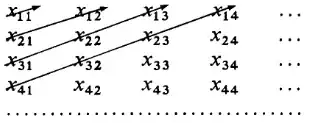This is a theorem proved in Rudin.
Theorem. Let $E_n, n=1,2,3,\ldots$ be a sequence of countable sets, and put $S=\bigcup_{n=1}^\infty E_n$. Then $S$ is countable.
Proof. Let every set $E_n$ be arranged in a sequence $x_{nk}, k=1,2,3,\ldots$, and consider the infinite array $$\begin{array}{cccc} x_{11}&x_{12}&x_{13}&\cdots\\ x_{21}&x_{22}&x_{23}&\cdots\\ x_{31}&x_{32}&x_{33}&\cdots\\ \vdots&\vdots&\vdots&\ddots \end{array}$$ in which elements of $E_n$ form the $n$th row. The array contains all elements of $S$. As indicated by the arrows in this picture —
— these elements can be arranged in a sequence $$x_{11};x_{21},x_{12};x_{31},x_{22},x_{13};x_{41},x_{32},x_{23},x_{14};\ldots.\qquad(17)$$ If any two of the sets $E_n$ have elements in common, these will appear more than once in $(17)$. Hence there is a subset $T$ of the set of all positive integers such that $S\sim T$, which shows that $S$ is at most countable (Theorem 2.8). Since $E_1\subset S$ and $E_1$ is infinite, $S$ is infinite, and thus countable.
I've a hard time visualizing/understanding the last part of the proof though[(17) onwards], will someone please give an intuitive explanation/description of the last paragraph to help me in understanding the proof?
